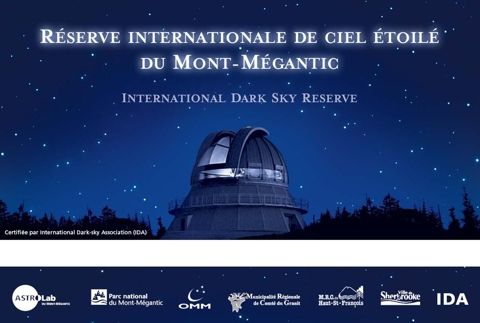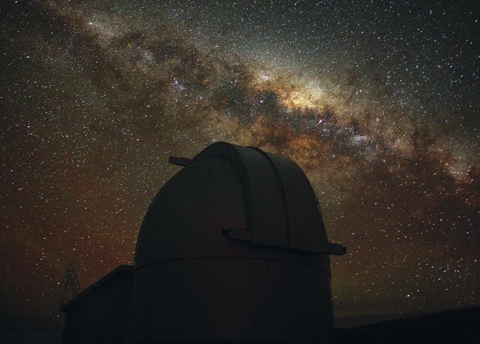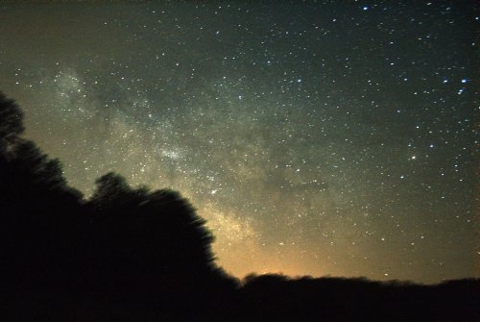
Fig.1. An information board in the Canadian national park Mont-Mégantic. In 2007 the park became the first IDA International Dark-Sky Reserve. (credit: International Dark-Sky Association)

Fig.2. Night sky above New Zealand Mt John observatory. The observatory is located above Lake Tekapo (Aoraki National Park). Currently a work is in progress to inscribe Aoraki National Park on the World Heritage List and/or on the Biosphere Reserve List as the first Starlight Reserve (credit: StarLight - a common heritage, page 154). More information about the initiative can be found here.

Fig.3. A night at the Hungarian Zselic Landscape Protection Area. At present Zselic is one of three dark sky parks existing in Europe. (the photo taken from here). More information can be found here.
nocturnal darkness conservation
The phrase „light pollution” seems to be a bit strange - the words „pollution” and „light” somehow do not macht. The light brings to mind good connotations and does not recall any pollution. The exhorting to preserve the darkness sounds astonishing, as well.
Our feeling results from light and dark symbolism deep-rooted in us. The light symbolizes life, goodness, happiness, truth, ect., while dark is a symbol of death, evil, sorrow, lie, ... Such a symbolism come out of the fact that we are species that since the beginning of their existence have been active only at day and we are adapted to such activity. Our main sense - eyesight, is weak at dark. Therefore a night was more dangerous period than a day for a prehistoric human. It was harder to orientate and to perceive danger from predators in darkness. Acquiring the ability to control fire was also important because it gave a human possibility to defence against darkness dangers. The further civilization progress is also history of more and more perfect sources of artificial light, allowing us to extend our period of activity into night.
We can almost turn a night into a day thanks to gas discharge lamps that have been used since the mid 20th century. Cites have become islands of light which can be easily seen from space on the night side of the Earth. Even though we got the power over darkness, the fear of it remains. The fear manifests itself when we have to walk a faintly lighted street or through a dark park or when suddenly light goes out in our home. To understand that excess of artificial light is harmful and that darkness is necessary, we have to forget about our fear of darkness and to look at the problem from in different perspective. There is continuous succession of day and night from the very beginning of the Earth's existence. The life that had appeared on our planet adapted to these periodic changes as it adapted to existence of other non-living components of the natural environment. Darkness (and light) is the same component of the environment as the air, soil, water and rocks. If we protect the environment against negative effects of human activities, we should also protect darkness being endangered by unwise usage of artificial light.
Understanding the light pollution problem leads to conclusions that contradict light and dark symbolism: light may be harmful and dark is necessary. A balance between light and dark is needed. Fortunately compromise is possible. To achieve it we firstly have to use artificial lighting wisely and secondly, preserve these regions on the Earth which are not or are slightly polluted by light. Such areas of nocturnal darkness preservation may fulfil functions as follows (a given area may fulfil more than one of these functions):- Preservation of the darkest nooks on our planet, where nocturnal environment is not disturbed by artificial light. Such areas are equivalents to nature reserves protecting uniquely valuable ecosystems.
- Popularization of knowledge about light pollution. Showing areas offering, at least locally, significant resources of little light polluted nocturnal environment. Owning to this the areas allow society to gain knowledge about the pollution necessary to minimise its influence on environment.
- Protection of dark areas for astronomical observations. These areas surround astronomical observatories, allowing to research the universe in proper conditions. The light pollution makes professional sky observations difficult or even impossible.
Areas fulfilling the functions 1. or 2. are called dark-sky parks or reserves. Let’s talk about terminology. Saying about light pollution, a term „dark sky” is most often used. It is due to the following reasons:
- Firstly, it is evident for astronomers (amateurs and professionals) to talk about light pollution. No or slight light pollution is necessary for them for astronomical observations.
- Secondly (and this is even more important), darkness of night sky is a very good, easily perceptible indicator of nocturnal environment quality. Darker sky means that in a given area light pollution is smaller and therefore nocturnal environment (nocturnal darkness) is less disturbed by light pollution.
Taking into account the second from the above subjects, it is easy to understand that dark sky preservation is equivalent to nocturnal environment preservation. Therefore we can use terms „nocturnal darkness” and „dark sky” or „nocturnal darkness preservation” and „dark sky preservation” interchangeably.
Currently there are several such dark-sky parks and reserves in the world. They are located in North America and Europe. It is planned to establish such area in New Zealand. The existence of such reserves show that the darkness has joint the other endangered components of the natural environment. It is very important component but unfortunately this fact is not evident for community. Recently, darkness preservation is also gradually implemented at existing area of nature conservation, e.g. national parks. Keeping in mind that darkness is also a natural resource, such action seems to be not only logical but also necessary.

